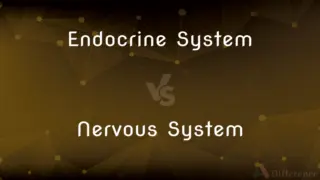Monocistronic mRNA vs. Polycistronic mRNA — What's the Difference?
By Tayyaba Rehman — Published on December 16, 2023
Monocistronic mRNA codes for a single protein, while Polycistronic mRNA codes for multiple proteins within one mRNA molecule.

Difference Between Monocistronic mRNA and Polycistronic mRNA
Table of Contents
ADVERTISEMENT
Key Differences
Monocistronic mRNA refers to messenger RNA molecules that possess the information to translate just one protein. In contrast, Polycistronic mRNA carries the instructions to produce multiple proteins.
In eukaryotic cells, Monocistronic mRNA is the norm. This means each mRNA represents a single gene and its corresponding protein product. However, in prokaryotic cells, Polycistronic mRNA is common, allowing for the simultaneous translation of several proteins from a single mRNA molecule.
The presence of Monocistronic mRNA ensures that each protein can be individually regulated in terms of its expression. With Polycistronic mRNA, a group of genes, often functionally related, can be transcribed and then translated together.
Monocistronic mRNA streamlines the process in eukaryotic cells by having one mRNA for one protein, simplifying regulation. In contrast, Polycistronic mRNA offers an advantage in prokaryotic cells by facilitating coordinated protein production.
In terms of gene regulation, Monocistronic mRNA offers more flexibility for eukaryotes, while Polycistronic mRNA supports efficient and coordinated gene expression in prokaryotes.
ADVERTISEMENT
Comparison Chart
Number of Proteins Encoded
One
Multiple
Common in
Eukaryotic cells
Prokaryotic cells
Regulatory Flexibility
High (individual protein regulation)
Coordinated (group regulation)
Genomic Organization
Single gene per mRNA
Multiple genes per mRNA
Example of Organism
Humans, plants, and other eukaryotes
Bacteria like E. coli
Compare with Definitions
Monocistronic mRNA
An mRNA molecule encoding a single protein.
Each Monocistronic mRNA results in one specific protein in eukaryotic cells.
Polycistronic mRNA
An mRNA molecule encoding multiple proteins.
A single Polycistronic mRNA in bacteria can lead to several proteins.
Monocistronic mRNA
A representation of eukaryotic gene expression.
Monocistronic mRNA is a hallmark of eukaryotic gene transcription.
Polycistronic mRNA
A transcript encompassing multiple genes.
In prokaryotes, multiple genes may be transcribed into one Polycistronic mRNA.
Monocistronic mRNA
An mRNA type allowing individual protein regulation.
With Monocistronic mRNA, each protein's production can be finely tuned.
Polycistronic mRNA
A molecule aiding in efficient bacterial gene expression.
Polycistronic mRNA ensures efficient and simultaneous production of proteins in bacteria.
Monocistronic mRNA
The opposite of polycistronic in terms of protein coding.
Unlike Polycistronic mRNA, a Monocistronic mRNA translates into only one protein.
Polycistronic mRNA
A representation of prokaryotic gene expression.
Polycistronic mRNA exemplifies the coordinated gene regulation in bacteria.
Monocistronic mRNA
A transcript from a single gene.
One gene in eukaryotes typically produces one Monocistronic mRNA.
Polycistronic mRNA
An mRNA type facilitating coordinated protein production.
Using Polycistronic mRNA, bacteria can produce related proteins simultaneously.
Common Curiosities
What organisms primarily use Polycistronic mRNA?
Prokaryotic organisms, like bacteria.
How is Polycistronic mRNA different?
Polycistronic mRNA encodes multiple proteins within one mRNA molecule.
Where is Monocistronic mRNA typically found?
In eukaryotic cells, like those of humans and plants.
Can a eukaryote have Polycistronic mRNA?
While rare, some exceptions exist, but Monocistronic mRNA is the norm.
Is the protein output always single for Monocistronic mRNA?
Yes, one Monocistronic mRNA leads to one protein.
Why is Monocistronic mRNA beneficial?
It allows for individual regulation of protein production.
How does Polycistronic mRNA aid bacteria?
It facilitates the coordinated production of related proteins.
What's the advantage of Polycistronic mRNA in gene regulation?
It allows for simultaneous expression of functionally related genes.
What determines whether an mRNA is mono or polycistronic?
The organism's cell type and the genomic organization play roles.
What is Monocistronic mRNA?
It's an mRNA molecule that codes for a single protein.
Do both mRNA types undergo translation similarly?
Yes, but Polycistronic mRNA will produce multiple proteins in one cycle.
Are there exceptions to the general rules of these mRNAs?
Yes, biology often has exceptions, but the descriptions provided are general norms.
How is protein regulation different between the two mRNAs?
Monocistronic mRNA offers individual regulation, while Polycistronic mRNA allows for group regulation.
How do these mRNAs impact biotechnology and research?
Understanding them aids in gene expression studies and microbial biotechnology.
Can Polycistronic mRNA code for unrelated proteins?
Typically, the proteins coded are functionally related.
Share Your Discovery

Previous Comparison
Corned Beef vs. Roast Beef
Next Comparison
Endocrine System vs. Nervous SystemAuthor Spotlight
Written by
Tayyaba RehmanTayyaba Rehman is a distinguished writer, currently serving as a primary contributor to askdifference.com. As a researcher in semantics and etymology, Tayyaba's passion for the complexity of languages and their distinctions has found a perfect home on the platform. Tayyaba delves into the intricacies of language, distinguishing between commonly confused words and phrases, thereby providing clarity for readers worldwide.












































